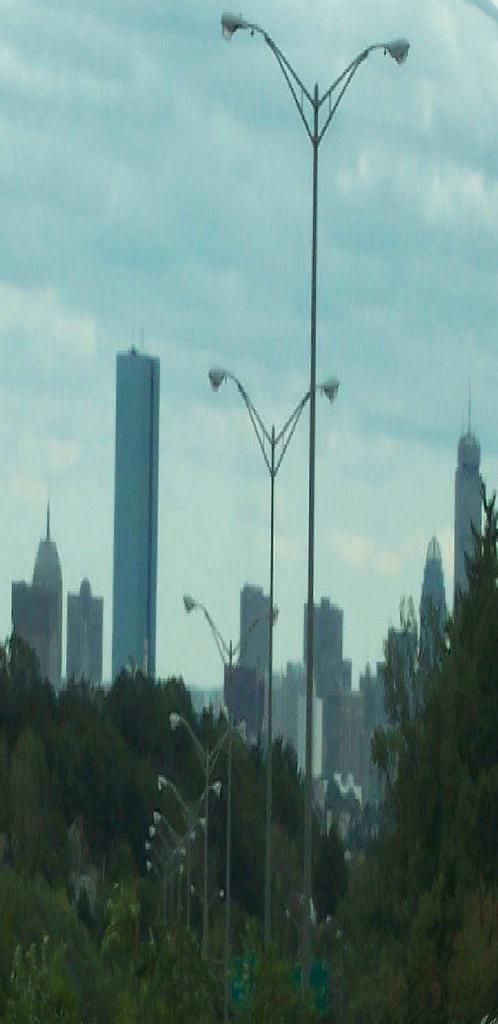Reaching lower heights?
Effort to protect Logan airspace could shorten new buildings
The Massachusetts Port Authority, moving to protect Logan International Airport from encroaching development, is adopting new height guidelines that could restrict the size of a future casino in East Boston as well as buildings in the financial district and along the Fort Point Channel in South Boston.
The guidelines establish a circle of protected airspace around Logan that is critical to maintaining flight paths and airport operations. Massport officials said any proposed development that exceeds the guidelines could be forced to cut its height.
"Our intent is to protect our airspace," said Flavio Leo, director of aviation planning for Massport, which runs Logan. "We're in a position where we need to maintain the airport's efficiency and safety over the long run."
The Federal Aviation Administration makes the final determination on the allowable height of buildings, but officials there said Massport's guidelines would inform their reviews and ensure the accuracy of decision-making.
The guidelines, unveiled this week, could have a significant impact on future development. A map of the height restrictions shows that buildings on the site of Suffolk Downs racetrack in East Boston must be kept between 125 to 250 feet - about 12 to 25 stories - potentially limiting attempts to build a high-rise casino or another large development.
An executive at Suffolk Downs said the track is reviewing the guidelines. "We are confident that we can continue to work cooperatively on potential future development of our property, especially development that will create much-needed jobs," said Chip Tuttle, chief operating officer at Suffolk Downs.
The restrictions could also limit the scale of development on a 16-acre parcel known as the postal annex along the Fort Point Channel, where the real estate firm Jones Lang LaSalle is weighing the possible dimensions of a mixed-use project.
Massport officials said the maximum height on the property would be between 290 and 325 feet, significantly less than the 400 feet allowed for development of a new glass office tower over nearby South Station. A spokesman for Jones Lang LaSalle said the restrictions will not affect the firm's plans.
"The postal project is 100 percent on firm ground," said the spokesman, Steve Steinberg.
Also affected would be future proposals for towers along the Massachusetts Turnpike between South Boston and the Back Bay, although existing proposals such as the $800 million Columbus Center project would not be affected, because it has already been permitted.
"We know this may affect a few sites, but overall it's consistent with our thinking about where height ought to be accommodated," said John Palmieri, executive director of the Boston Redevelopment Authority, the city's planning arm. "Obviously, the issues surrounding safety are compelling and we think we can work within this framework." The guidelines would make Logan the third US airport to develop comprehensive height limits, along with Miami and Phoenix. Logan is just three miles from downtown Boston, putting it closer to a city center than almost any other major US airport.
Discuss
COMMENTS (0)
Graphic Restrictions on the height of development around Boston
The primary goal of the guidelines is to ensure pilots have clear flight paths that eliminate the need for excessive maneuvering. Such maneuvering becomes untenable in low visibility conditions and can force airlines or controllers to switch runways, thus creating travel delays and reducing the efficiency of airport operations.
The guidelines are based on the hypothetical flight paths of planes that encounter difficulties taking off and landing at Logan. To create the height limits, Massport officials mapped the flight paths of planes that either lost one engine while taking off or had to abort a landing amid difficult weather conditions. Those scenarios would cause the planes to fly lower, necessitating that Massport protect airspace where they can safely navigate among buildings.
Airport officials said they are most concerned about protecting airspace over the waterfront in South Boston, where guidelines were first developed several years ago due to concerns raised by the FAA. Planes flying through the corridor have less room to maneuver because of the Federal Reserve Bank and other towers in the financial district.
Construction of a new tower would force Massport to change flight procedures for the use of runway 27, a move that could restrict takeoffs and landings during difficult weather conditions. No current developments exceed the height limits, but officials said they will monitor new proposals.
"That's that area that has had the most diminution of airspace flexibility," said Lowell Richards, chief development officer for Massport. "If the airlines or the FAA choose to use different runways, it could affect on-time performance as well as noise impacts in the city."
While creation of the guidelines represents a more concerted effort to restrict development, real estate professionals welcomed Massport's efforts as a way to eliminate confusion in the review process.
Currently, federal regulators review the height of buildings on a case by case basis, meaning developers have no precise knowledge about the limits on construction until they seek a formal review. In the spring, businessman Steve Belkin and city officials were told by the FAA that a plan for a 1,000-foot tower at Winthrop Square in downtown would obstruct flight traffic, adding to myriad complications facing the ambitious proposal. An FAA official said Belkin, whose tower would be limited to about 700 feet under Massport's guidelines, has not since asked for a formal review.
"This enables developers to do proper planning, because they know the restrictions going into it," said David Begelfer, chief executive of the Massachusetts office of the National Association of Industrial and Office Properties.
"Before, you might already have money committed to acquisition or permitting, only to find out that you have a height problem."
http://www.boston.com/business/articles/2008/09/26/reaching_lower_heights/?page=2
Effort to protect Logan airspace could shorten new buildings
The Massachusetts Port Authority, moving to protect Logan International Airport from encroaching development, is adopting new height guidelines that could restrict the size of a future casino in East Boston as well as buildings in the financial district and along the Fort Point Channel in South Boston.
The guidelines establish a circle of protected airspace around Logan that is critical to maintaining flight paths and airport operations. Massport officials said any proposed development that exceeds the guidelines could be forced to cut its height.
"Our intent is to protect our airspace," said Flavio Leo, director of aviation planning for Massport, which runs Logan. "We're in a position where we need to maintain the airport's efficiency and safety over the long run."
The Federal Aviation Administration makes the final determination on the allowable height of buildings, but officials there said Massport's guidelines would inform their reviews and ensure the accuracy of decision-making.
The guidelines, unveiled this week, could have a significant impact on future development. A map of the height restrictions shows that buildings on the site of Suffolk Downs racetrack in East Boston must be kept between 125 to 250 feet - about 12 to 25 stories - potentially limiting attempts to build a high-rise casino or another large development.
An executive at Suffolk Downs said the track is reviewing the guidelines. "We are confident that we can continue to work cooperatively on potential future development of our property, especially development that will create much-needed jobs," said Chip Tuttle, chief operating officer at Suffolk Downs.
The restrictions could also limit the scale of development on a 16-acre parcel known as the postal annex along the Fort Point Channel, where the real estate firm Jones Lang LaSalle is weighing the possible dimensions of a mixed-use project.
Massport officials said the maximum height on the property would be between 290 and 325 feet, significantly less than the 400 feet allowed for development of a new glass office tower over nearby South Station. A spokesman for Jones Lang LaSalle said the restrictions will not affect the firm's plans.
"The postal project is 100 percent on firm ground," said the spokesman, Steve Steinberg.
Also affected would be future proposals for towers along the Massachusetts Turnpike between South Boston and the Back Bay, although existing proposals such as the $800 million Columbus Center project would not be affected, because it has already been permitted.
"We know this may affect a few sites, but overall it's consistent with our thinking about where height ought to be accommodated," said John Palmieri, executive director of the Boston Redevelopment Authority, the city's planning arm. "Obviously, the issues surrounding safety are compelling and we think we can work within this framework." The guidelines would make Logan the third US airport to develop comprehensive height limits, along with Miami and Phoenix. Logan is just three miles from downtown Boston, putting it closer to a city center than almost any other major US airport.
Discuss
COMMENTS (0)
Graphic Restrictions on the height of development around Boston
The primary goal of the guidelines is to ensure pilots have clear flight paths that eliminate the need for excessive maneuvering. Such maneuvering becomes untenable in low visibility conditions and can force airlines or controllers to switch runways, thus creating travel delays and reducing the efficiency of airport operations.
The guidelines are based on the hypothetical flight paths of planes that encounter difficulties taking off and landing at Logan. To create the height limits, Massport officials mapped the flight paths of planes that either lost one engine while taking off or had to abort a landing amid difficult weather conditions. Those scenarios would cause the planes to fly lower, necessitating that Massport protect airspace where they can safely navigate among buildings.
Airport officials said they are most concerned about protecting airspace over the waterfront in South Boston, where guidelines were first developed several years ago due to concerns raised by the FAA. Planes flying through the corridor have less room to maneuver because of the Federal Reserve Bank and other towers in the financial district.
Construction of a new tower would force Massport to change flight procedures for the use of runway 27, a move that could restrict takeoffs and landings during difficult weather conditions. No current developments exceed the height limits, but officials said they will monitor new proposals.
"That's that area that has had the most diminution of airspace flexibility," said Lowell Richards, chief development officer for Massport. "If the airlines or the FAA choose to use different runways, it could affect on-time performance as well as noise impacts in the city."
While creation of the guidelines represents a more concerted effort to restrict development, real estate professionals welcomed Massport's efforts as a way to eliminate confusion in the review process.
Currently, federal regulators review the height of buildings on a case by case basis, meaning developers have no precise knowledge about the limits on construction until they seek a formal review. In the spring, businessman Steve Belkin and city officials were told by the FAA that a plan for a 1,000-foot tower at Winthrop Square in downtown would obstruct flight traffic, adding to myriad complications facing the ambitious proposal. An FAA official said Belkin, whose tower would be limited to about 700 feet under Massport's guidelines, has not since asked for a formal review.
"This enables developers to do proper planning, because they know the restrictions going into it," said David Begelfer, chief executive of the Massachusetts office of the National Association of Industrial and Office Properties.
"Before, you might already have money committed to acquisition or permitting, only to find out that you have a height problem."
http://www.boston.com/business/articles/2008/09/26/reaching_lower_heights/?page=2




